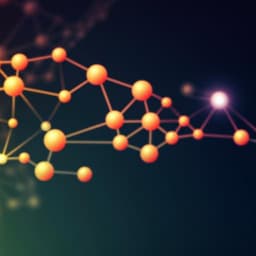
Social Work
The temporal dynamics of group interactions in higher-order social networks
I. Lacopini, M. Karsai, et al.
This research investigates how individuals navigate and form groups within social networks, revealing robust patterns that apply in both childhood and university settings. Conducted by Iacopo Lacopini, Márton Karsai, and Alain Barrat, this study offers valuable insights into social dynamics and proposes a dynamical model that closely mirrors real-world interactions.
~3 min • Beginner • English
Introduction
The study investigates how human social interactions unfold in groups, moving beyond traditional network models that capture only pairwise contacts. While higher-order representations are increasingly used, the mechanisms driving group formation, stability, transitions between groups, and the temporal evolution of group interactions remain insufficiently understood. The authors aim to characterize the temporal dynamics of groups at both individual and group levels using empirical proximity data in distinct social contexts (preschool and university). They seek to identify robust patterns in group change, duration, aggregation and disaggregation, and to propose a dynamical model that reproduces these patterns and can serve as a substrate for studying processes (e.g., contagion, consensus) that evolve on higher-order temporal structures.
Literature Review
Prior work in network science has revealed rich structure and dynamics in temporal networks, including memory, burstiness, and non-Poissonian inter-event times. However, standard networks are limited to pairwise interactions and do not fully capture group phenomena. Research on higher-order networks and hypergraphs has shown that group interactions shape processes such as social contagion, opinion dynamics, consensus formation, and cooperation, and that higher-order structures can exhibit hierarchical, nested, and temporally correlated patterns. Findings include heterogeneous group sizes, shorter durations and weaker temporal correlations for larger groups, preferred temporal direction in formation/fragmentation, and recurrence of groups shaped by contexts and places. Mechanisms such as simplicial closure and homophily have been proposed, and models of temporal interactions have largely focused on pairwise contacts, leaving a gap in understanding and modelling group-level temporal dynamics.
Methodology
Data and group extraction: Two temporally resolved proximity datasets were analyzed. (1) University (Copenhagen Network Study, CNS): Bluetooth-based proximity among 706 freshmen over four weeks, 5-minute resolution. Data were split into contexts: workweek in-class (Mon–Fri 8:00–17:00), workweek out-of-class (Mon–Fri 00:00–8:00 and 17:00–23:59), and weekend (Sat–Sun). Pre-processing included removing external devices, RSSI thresholding (retain > −90 dBm), smoothing intermittent gaps, removing single-timestep spurious links, and a triadic closure step with an added RSSI threshold of −75 dBm for newly created links to avoid weak closures; empty scans were treated as isolation events; isolated nodes were re-added if necessary. Final processed records totaled ~3.99 million. (2) Preschool (DyLNet): RFID-based face-to-face proximity among 174 children (adults removed) over 10 months, 5-second resolution; interactions shorter than 10 seconds were removed due to daily clock desynchronization. Contexts were split into in-class (same-class interactions entirely during class time) and out-of-class (free-time interactions fully within free-time windows). Isolated records were added for timestamps where a child did not interact but was active in the session.
Group definition: At each timestamp, groups were defined as maximal cliques in the instantaneous proximity network, yielding a temporal hypergraph. Nodes could be isolated (group size 1) or belong to one or more groups, though empirically most belonged to a single group at a time.
Analytical measures: (i) Node-centric transition matrices T_{kk'} were constructed to measure conditional probabilities that a node undergoing a group change moves from group size k at time t to size k' at t+1, with normalization by the target size to ensure comparability across k'. (ii) Group durations: groups were tracked as identical sets of members across consecutive timestamps; birth and death times defined durations. Distributions P(τ) were computed per group size. (iii) Aggregation/disaggregation: for each group of size k, the size of the largest subset of its members present immediately before its birth and immediately after its death was measured to characterize how groups assemble and disassemble across sizes. (iv) Group-change probability P(k, τ): for each node in a group of size k, the probability of leaving after residence time τ was estimated. (v) Social memory: when a node changed groups, the fraction of members in the new group previously known to the node was measured and compared to two null models (uniform random choice among available groups; and random choice constrained to the empirical target group size).
Model: A temporal hypergraph model was proposed with N agents, each in at most one group at a time. At each epoch, agents are updated in random order via two mechanisms. Mechanism 1 (leaving/staying): the probability for agent i to change group after residence time τ in a group of size k follows a long-gets-longer rule, decreasing with τ, fitted from data with a power-law form and a group-size-dependent prefactor b_k that increases with k and is modeled by a logistic function b_k = 1/(1 + exp[−α(k − k0)]). Mechanism 2 (choosing a new group): upon leaving, i selects a new group from the set of available groups and an empty-group option (multiple copies of the empty set weighted by ε control isolation propensity). The selection probability is proportional to the post-joining density of known alters in the candidate group, incorporating social memory of past contacts. The model thus couples temporal memory (residence-time dependence) and social memory (preference for known alters) to generate higher-order interactions.
Fitting and simulation: For illustration, university out-of-class data were targeted. Simulations used N = 700 agents, T = 2000 time steps, with grid search over parameters θ = {ε ∈ [1,30], α ∈ [0.05,0.95], k0 ∈ [3,14]} and β set from empirical fits (e.g., β ≈ 0.8). The best parameter set minimized a joint Kullback–Leibler divergence between empirical and simulated group-size distributions and node transition matrices. Additional observables (durations; aggregation/disaggregation) were used for qualitative validation.
Key Findings
- Group size distributions are heterogeneous across contexts, with university interactions exhibiting larger maximal group sizes than preschool, likely due to Bluetooth range. In freer contexts (out-of-class, weekend), individuals tend to gather in smaller groups.
- Node-centric transition matrices show robust patterns across datasets and contexts: for small k, the most likely next size is to remain at k (except k = 1, which most often transitions to k' = 2); transitions predominantly occur near the diagonal (small size changes), and for larger k there is an increasing bias toward moving to smaller groups.
- Group duration distributions P(τ) are heavy-tailed for all sizes and contexts. Smaller groups exhibit broader tails and longer average/max durations than larger groups. Periods of isolation (group size 1) display burstiness, consistent with non-Poissonian inactivity intervals at the node level. Group-level inter-event times are also broadly distributed.
- The probability that a node changes group decreases with the residence time τ spent in that group (long-gets-longer effect), consistent across contexts and sizes. Empirical fits indicate a power-law decay with a common exponent β (e.g., β ≈ 0.8 in university out-of-class), while the size-dependent prefactor b_k increases monotonically with k and is well captured by a logistic function.
- Aggregation and disaggregation dynamics are largely hierarchical and approximately symmetric: small groups tend to grow gradually; medium/large groups typically form by a slightly smaller group being joined by small groups; large groups typically disaggregate by shedding small subsets, remaining medium-to-large rather than splitting into equal halves.
- Strong social memory is present: when changing groups, individuals join groups containing a significantly higher fraction of previously known alters than expected under random choice (both unconstrained and size-constrained baselines), across datasets and contexts.
- The proposed model, fitted to data, reproduces key empirical features: group-size distributions, node-centric transition matrices (including symmetry for small sizes and bias toward smaller sizes at large k), heavy-tailed group duration distributions with size dependence, and the hierarchical aggregation/disaggregation patterns.
Discussion
The results demonstrate that the temporal dynamics of group interactions exhibit robust, context-independent signatures across very different populations (university students and preschool children) and settings (in-class, out-of-class, weekend), and similar patterns are observed in additional conference datasets. These findings address the central question by showing that simple, memory-based microscopic mechanisms can explain complex higher-order temporal patterns: individuals linger longer in established groups and preferentially rejoin groups with known alters, yielding characteristic transition, duration, and assembly/disassembly statistics. The study advances the representation of social systems beyond pairwise interactions, providing a data-driven model that captures both individual navigation across groups and group-level evolution. This has direct relevance for understanding and simulating processes that depend on group interactions, such as social contagion, consensus formation, and cooperation, especially on temporally evolving higher-order structures.
Conclusion
The study characterizes robust temporal patterns of group formation, persistence, and change in human social interactions across diverse contexts and proposes a dynamical model that reproduces these higher-order phenomena by combining temporal and social memory. The model offers a realistic synthetic substrate to study dynamics on temporal hypergraphs and highlights the importance of explicitly modelling group interactions. Future work should: (i) develop quantitative measures to compare temporal hypergraphs; (ii) test robustness under alternative definitions or inference of hyperedges from pairwise data; (iii) incorporate additional behavioral mechanisms (e.g., homophily, co-evolving opinions, richer memory); (iv) extend analyses and models to non-human animal systems, integrating ecological drivers; and (v) explore microfounded, game-theoretic formulations balancing costs and benefits of group sizes.
Limitations
Analyses rely on groups reconstructed from pairwise proximity, which are proxies for real group encounters and depend on temporal resolution and pre-processing choices (e.g., RSSI thresholds, triadic closure). There is no universally accepted quantitative metric to compare temporal hypergraphs, complicating rigorous cross-context comparisons; datasets also differ in size and maximal group sizes, leading to differing cut-offs. The study remains phenomenological, avoiding claims of universality or precise functional forms for broad distributions. Preschool data lack weekend coverage; device synchronization issues required discarding very short interactions. Results may vary under alternative group extraction or hyperedge inference methods and in contexts with different constraints.
Related Publications
Explore these studies to deepen your understanding of the subject.







